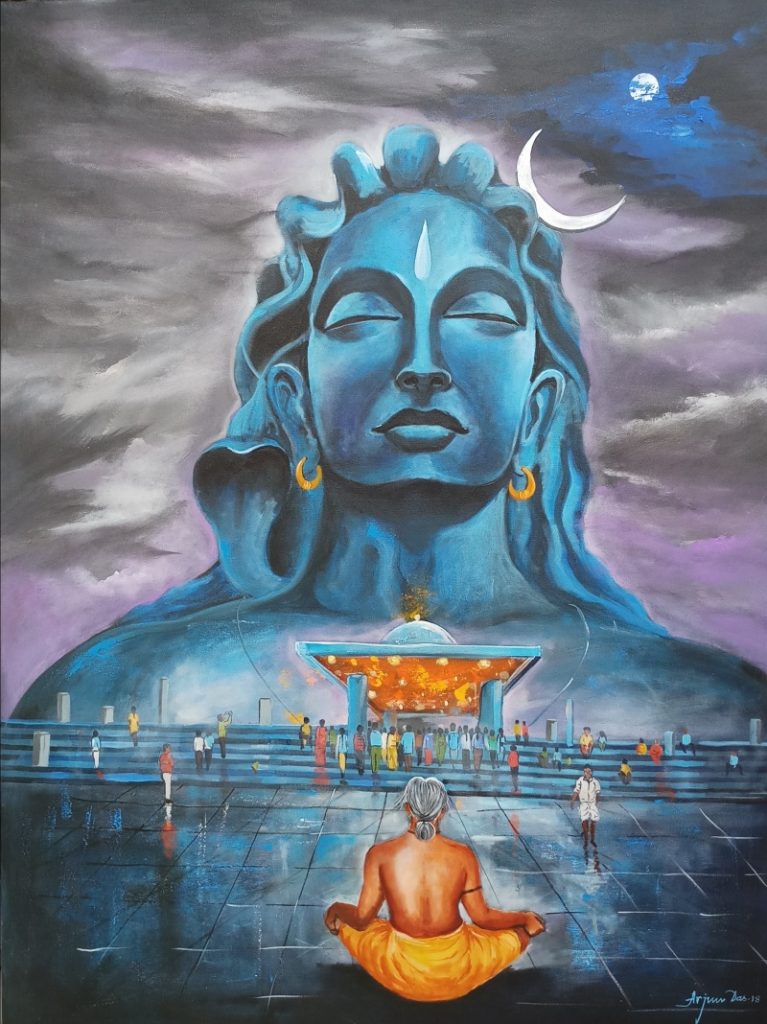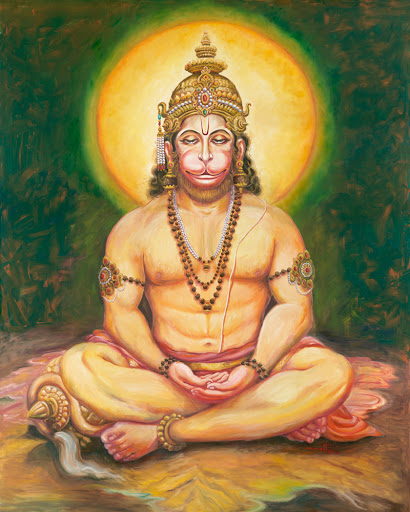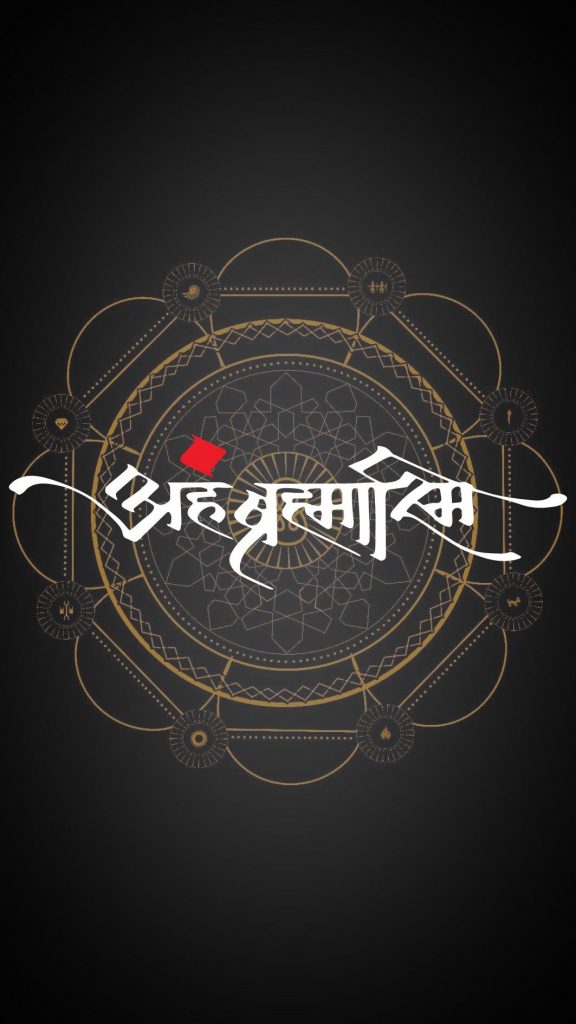Exercise 11
Soham Meditation
Difficulty level – 1 (easy)
Time commitment : 10 minutes thrice a week

As we enter the second phase of our sādhanā, it’s time to introduce to you our first meditation exercise.
A few points to note:
- Time to practice – Ideally before sunrise or during sunset. However, for beginners, early morning or late evening (before sleeping) is fine, but on an empty stomach (2 hours after eating a light meal). If possible, choose a particular time of the day, and stick to it every time.
- Place – A calm, quiet and well-ventilated place would do. You can do this in a puja room, or place of prayer. Ensure that you practice this meditation at the same place every time.
- Yoga mat – is not necessary for this practice. A rug would suffice. Not too soft though.
How you do it

- Sit in a comfortable position. Ideally in Sukhasana or Vajrasana. Avoid sitting on a chair. Keep your back straight. If you find this difficult, try the Vajrasana posture since the back is naturally straight in this āsana. Your hands can be kept loosely on your thighs, palms facing down, or if you know how to do it, in jnana mudra. Close your eyes. Breathe normally.
- Turn your eyes slightly downward and close them gently. During meditation your eyes may move upward and downward naturally – don’t try to control this movement.
- Be aware of your natural breath flowing in and out. Breathe through your nose, keep your jaw muscles relaxed, so that your teeth are not clenched or tensed.
- Now become aware of the incoming breath, and mentally intone a long “So” that starts when you start to inhale, and continues throughout the inhalation. You do not have to pronounce it, or even curl your lips. The intonation should be silent, and in the mind, and if heard externally, would sound like “SOooooooooooooo”.
- Now become aware of the outgoing breath, and mentally intone a long “Hum” that starts as you exhale, and continues throughout the exhalation. The intonation should be silent, and in the mind, and if heard externally, would sound like “HUMmmmmmmmmmmmm”.
- As you breathe naturally, the intonations would sound (if heard externally) like SOoooooooooooHUMmmmmmmmmmSOoooooooooooHUMmmmmmmmmm…
- If the breath is short, the intonation should be short; if long, then the intonation should be long. It does not matter if the inhalations and exhalations are not of equal length. The emphasis here is on natural and spontaneous breathing, and observation.
- If you find thoughts arising, or you hear external sounds, don’t force yourself to shut them out. Be aware, and then gently bring back your attention to your breath. Think that you are waiting at a bus stop and watching a bus pass by. It may stop, but don’t board this bus. I think of my attention as a big blue ball (like the exercise ball that people sit on in lieu of a chair) – when I find my thoughts wavering – I bring the big blue ball of my attention back to the centre of my forehead.
- Don’t try to concentrate on your Ājñā chakra (third eye in the middle of the eyebrows). This meditation is for awareness, and focus on the incoming and outgoing breath.
- If you feel a lot of distraction, take a deep breath, and as you exhale, feel the tensions and distractions flowing out of your body (like the receding waters of the sea at a beach). Then, continue as before.
- Practice this meditation for 5 minutes at the beginning, moving on to 10 minutes by the end of the 21-day sādhanā.

Breathing
Gentle breathing, without strain or effort. Take in deep slow inhalations, with an expanded chest, and deep slow exhalations, with your stomach moving towards your spine. Your breathing should not be noisy – rather, should feel like the gentle waves of a calm ocean.
Awareness
Maintain awareness on the incoming and outgoing breath. If thoughts arise, be aware, but don’t participate. You do not need to focus or concentrate – just be aware.
Benefits
This meditation is a basic practice to make you aware of your natural breath. It leads to a calmer and more aware mind. As you lengthen the practice of Soham meditation, you will find yourself moving towards the true meaning of Soham – self realisation.
Things to note
The key to meditation is feeling. Without an inner feeling, sitting with your eyes closed is just a bad way to sleep.
Soham meditation comprises a) sitting with the eyes closed; b) being aware of your incoming and outgoing breath; c) mentally intoning SoHum in tune with your breath and d) listening to those mental intonations: all in a relaxed and easeful manner, without strain. As you progress, you will find yourself mentally intoning SoHum in tune with your breath throughout the day, without any additional effort or allocation of a particular time.
सोऽहम is a compound word made from सः (he) and अहम् (I). Such a simple word, but the meaning of this word is the essence of all Vedic thought. He is I – I am He.
Soham is an अजप मंत्र (Ajāpa Mantra) – a mantra that doesn’t have to be pronounced. Swami Satyananda Saraswati said, “When the name is uttered from the mouth, it is called japa; when it is uttered from the heart, it is called ajapa.” Japa also refers to conscious chanting of a mantra, and when the mantra is in sync with the breath and meditation, the mantra flows without exertion.
Some call this the greatest of all Mantras. Remove the S and the H, and you get ॐ (Om) – and so Soham is a modified version of Om, tailored for practice 21,600 times a day, without any effort from your side. We are born performing this meditation, and will die performing this mediation. If you notice carefully, “So” is the sound of the natural incoming breath, and “Hum” is the sound of the natural outgoing breath. So you practice this mediation even when sleeping!

सोऽहम (Soham), तत्त्वमसि (Tat Tvam Asi), अहम् ब्रह्मास्मि (Ahaṁ Brahmāsmi) , शिवोऽहम् शिवोऽहम् (Shivōham Shivōham) – and many other such Vedic mantras all emphasise the same fact. We are drops of water from the same ocean, not separate, not distinct – and just as water drops from the ocean are as salty, we carry within us the same characteristics of the universal consciousness – the same divinity. And when we are done, when it is time to go back, we return to the ocean, our identities merged into those ocean waters, that universal consciousness, no single drop distinct or separate from the whole…
पूषन्नेकर्षे यमसूर्य प्राजापत्य
व्यूह रश्मीन् समूह ।
तेजो यत्ते रूपं कल्याणतमं तत्ते पश्यामि
योऽसावसौ पुरुषः सोऽहमस्मि ॥
pūṣannekarṣe yamasūrya prājāpatya
vyūha raśmīn samūha |
tejo yatte rūpaṃ kalyāṇatamaṃ tatte paśyāmi
yo’sāvasau puruṣaḥ so’hamasmi ||
Iśa Upaniśad Mantra 16
O, Nourisher, O lonely Courser
of the heavens, O Regulator,
O Sun, thou offspring of Prajapati,
Remove Thy rays, gather up thy effulgence,
So that I may see that which is
Thy most auspicious effulgence.
The Person that is in Thee, That am I.
I came to know that onion and garlic are the same.
If a man fry onion he will have no tasty dish.
If a man fry garlic, let him not eat a scrap thereof.
Therefore found I the flavor of Soham.
(Lalla Vakyani 90)
